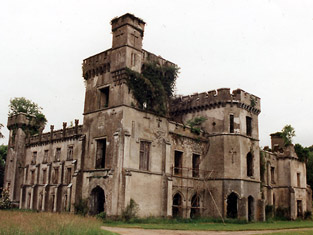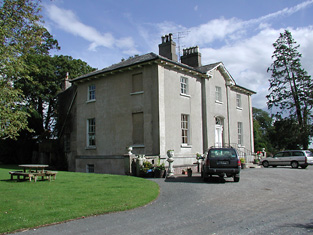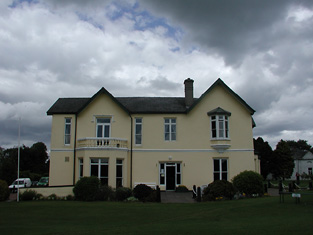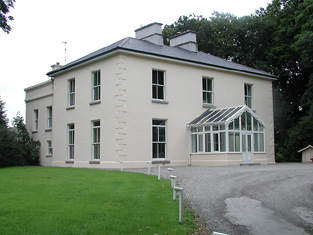Liscahill [Lodge]
Houses within 5km of this house
Displaying 14 houses.
Houses within 5km of Liscahill [Lodge]
Displaying 14 houses.
| House name | Description | |
|---|---|---|
| Castle Fogarty | Lewis writes that Castle Fogarty was "the ancient seat of the O'Fogarty family from whom it descended to the present proprietor J. Lanigan". He describes it as a "square castellated mansion, with embattled towers at the angles". The seat of the Lenigan family in the 18th and 19th centuries [held from the Earls of Portarlington until the fee was purchased in the mid 19th century]. Noted by Slater as the seat of Captain Vivian Ryan-Lanigan in 1894. A ruin since it was burnt in 1922. |

|
| Mountalt | Occupied by Martin Ryan in 1814 and in 1837 and held from J. Lenigan. James Lenigan is recorded as the occupier at the time of Griffith's Valuation, holding the property in fee, when the farm house and offices were valued at £7. | |
| Crossoge | Lewis refers to Prior Lodge as the residence and property of the Reverend Dr Prior. The house in Crossoge is named Prior Lodge on the first edition Ordnance Survey map. This house appears to have been replaced by another building, a short distance to the south, known as Crossoge House sometime in the mid 19th century. Occupied and held in fee with 92 acres by the Reverend John Prior at the time of Griffith's Valuation when the buildings were valued at £25.15 shillings. This house is still in use as a country residence. [This may be the house to which Wilson, writing in 1786, refers to as"Bachelor's Lodge", in this area, which was a seat of Mr. Roe]. |

|
| Brittas Castle | The original castle was burnt circa 1820 (Bence Jones) when the owner was Henry Grace Langley. His nephew Major Henry Langley began to build a Medieval Revival castle to the design of William V. Morrison but died when only the gate tower was completed. The Irish Tourist Association surveyor wrote that it was to be a replica of Warwick Castle. In 1840 the Ordnance Survey Name Books commented that Brittas Castle was "a modern unfurnished building on a most magnificent scale but in all probability it will never be finished"! In the mid 19th century Henry Langley held the castle valued at £30 from the Court of Chancery. The sale rental of December 1853 records Thomas Kirwan as the tenant of the castle and 464 acres for 7 years from 25 March 1851 pending the cause of Langley v Langley. From 1853 Brittas belonged to the Knox family who lived in a single storey house located behind the gate tower. This house was described as a mansion house in 1906, valued at £25 and occupied by Fitzroy Knox. |

|
| Ballycahill | A house at Ballycahill valued at £11+ was occupied by Mrs Mary Cormack at the time of Griffith's Valuation and held from Doctor Wall. | |
| Farney Castle | A seat of a branch of the Armstrong family. Wilson refers to this property as Farney Bridge in 1786, a seat of Mr. Armstrong. It was occupied by Captain Armstrong in 1814 and 1840, when the Ordnance Survey Name Books describe it as "a circular old castle to which a gentleman's residence has been attached". Major William Armstrong was the occupier in the early 1850s. The buildings were then valued at £42.10 shillings and held from the Reverend Garrett Wall. It was still in Armstrong possession in the 1870s. Farney Castle is still extant and occupied. |

|
| Cabragh Castle | The home of James Fogarty in 1814. In 1840 the Ordnance Survey Name Books refer to P. Fogarty as the proprietor of "Cabra House". Denis Leahy was the occupier in the mid 19th century when the castle was valued at £16+ and held from the Court of Chancery. | |
| Turtulla | A member of the Blunden family was living at "Turkla" close to Thurles in the 1770s. William Nicholson was living at Turtola in 1814. Lewis writes in 1837 that it was the property of Valentine Maher but that John B. O'Brien was resident. A flour mill was located on the property. In 1840 the Ordnance Survey Name Books record a Mr. Lister in charge of the mill. They refer to Valentine Maher as the proprietor. By the time of Griffith's Valuation Nicholas Maher was the occupier. He held the property from the Court of Chancery and the buildings were valued at £50+. Nicholas had succeeded his cousin Valentine in 1844 and died without heirs in 1871. Turtulla then became the home of the Barry family from county Limerick. It was unoccupied from 1927 to 1944 when it was purchased by the Thurles golf club and has been their club house since then. see http://www.thurlesgolfclub.com/cluboverview.html |

|
| Raheen Park | Located south east of Farneybridge this house was occupied by Edward Wilson in the mid 19th century, valued at £34 and held from William B. Armstrong. Raheen Park may have been previously known as Brasfort. Brasfort was the home of the Wilsons in the 1830s. Edward Wilson was Chief Magistrate of Police in county Tipperary in the 1820s. In 1820, his son, Edward Wilson, married Isabella, daughter of Thomas Goodricke Peacock of Fort Etna and they had a son, Thomas Goodricke Wilson, who married Mary Studdert in 1861 and emigrated to Canada. In 1840 the Ordnance Survey Name Books refer to E. Wilson as the proprietor of Raheen Park. Edward Wilson of Raheen Park died at Monkstown, county Dublin in 1880, aged 81, (see D.23260 in the National Archives). | |
| Dovea | A house built circa 1830s and occupied by J. Trant in 1837. The Ordnance Survey Name Books describe it as "a handsome residence" in 1840, though it mentions Mr. Ellis as the actual resident. John Trant held the property in fee at the time of Griffith's Valuation when the buildings were valued at £79+. This house was still in the possession of the Trant family at the beginning of the 1940s but by the time of the Irish Tourist Association Survey had been bought by Ballduff Co Operative, Thurles, who had plans to turn it into a model farm. It is now the headquarters of Dovea Genetics, see http://www.dovea.ie/html/history_of_dovea.html. |

|
| Kilrush | In 1840 the Ordnance Survey Name Books refer to Kilrush House as a gentleman's residence, possibly that of a Mr. Fogarty. John Ellis was occupying a house valued at £14 in Kilrush at the time of Griffith's Valuation. He held the property from John Trant who held 210 acres from James Byron. A house is still extant at this location. | |
| Ardfort House | The National Inventory of Architectural Heritage dates this house from approximately 1875. It was the home of the O'Brien family of Thurles and is still extant. |

|
| Dovea (Killahara) | A house built in the late 19th century and occupied by Major Fitzgibbon Trant in 1906 when the buildings were valued at £31+. Lewis writes that there was “a very fine old castle” at Killahara, which formerly belonged to Purcells but was then (1837) the property of Mr Trant. |

|
| Beakstown House | Major Ledwell was resident at Beakstown in 1837 and the Ordnance Survey Name Books also mention it as his residence in 1840. At the time of Griffith's Valuation one house at Beakstown appears to be in use as an auxiliary poorhouse, held by the Reverend George Peacock from the Court of Chancery and valued at £22+. Another property seems to be labelled Abbey View on the 1st Edition Ordnance Survey map but as Beakstown Cottage on the 25-inch map of the 1890s. The OS Name Books refer to this house as the residence of Mr. Mullvany, proprietor of Beakstown Flour Mills nearby. The name Beakstown Cottage had previously belonged to another property in Beakstown which is still extant [S087559]. The original Beakstown House does not appear to be extant. |

